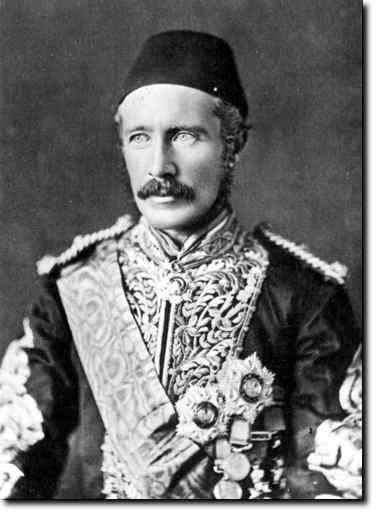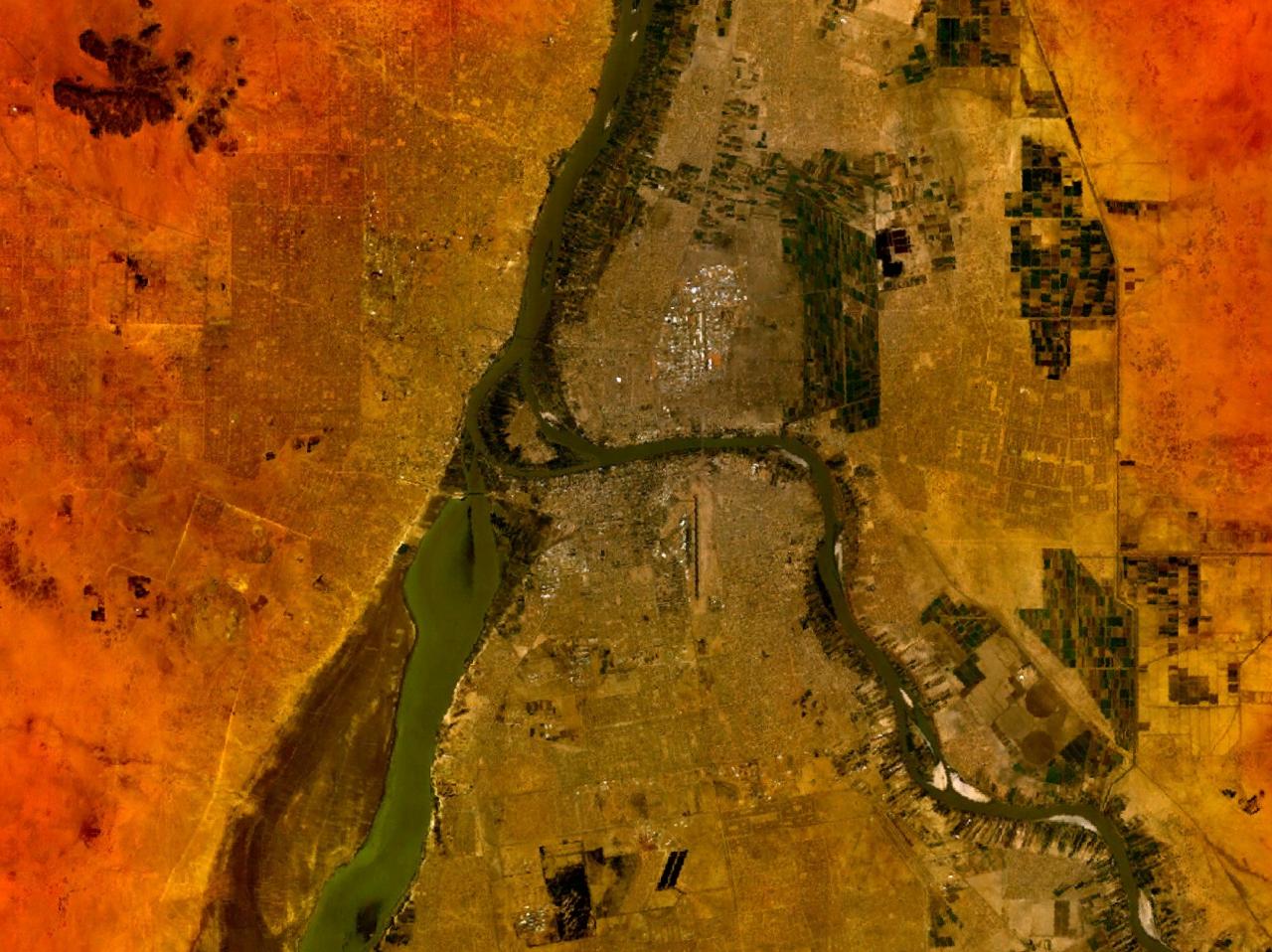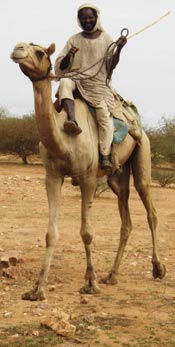|
Khartoum
Khartoum or Khartum is the capital city of Sudan as well as Khartoum State. With an estimated population of 7.1 million people, Greater Khartoum is the largest urban area in Sudan. Khartoum is located at the confluence of the White Nile – flowing north from Lake Victoria – and the Blue Nile, flowing west from Lake Tana in Ethiopia. Divided by these two parts of the Nile, the Khartoum metropolitan area is a tripartite metropolis consisting of Khartoum proper and linked by bridges to Khartoum North ( ) and Omdurman ( ) to the west. The place where the two Niles meet is known as ''al-Mogran'' or ''al-Muqran'' (; English: "The Confluence"). Khartoum was founded in 1821 by Muhammad Ali of Egypt, Muhammad Ali Pasha, north of the ancient city of Soba (city), Soba. In 1882 the British Empire Anglo-Egyptian War, took control of the Egyptian government, leaving the administration of Sudan in the hands of the Egyptians. At the outbreak of the Mahdist War, the British attempted to evacu ... [...More Info...] [...Related Items...] OR: [Wikipedia] [Google] [Baidu] |
Siege Of Khartoum
The siege of Khartoum (also known as the battle of Khartoum or fall of Khartoum) took place from 13 March 1884 to 26 January 1885. Mahdist State, Sudanese Mahdist forces captured the city of Khartoum, Sudan, from its Khedivate of Egypt, Egyptian garrison, thereby gaining control over the whole of Turco-Egyptian Sudan. Egypt had Turco-Egyptian conquest of Sudan (1820–1824), conquered Sudan in 1820, but had itself come under History of Egypt under the British, British domination in 1882. In 1881, the Mahdist War began in Sudan, led by Muhammad Ahmad who claimed to be the Mahdi. The Egyptian Army was unable to suppress the revolt, being defeated in several battles and retreating to their garrisons. The British refused to send a military force to the area, instead appointing Charles George Gordon as Governor-General of Sudan, with orders to evacuate Khartoum and the other garrisons. Gordon arrived in Khartoum in February 1884, where he found it impossible to reach the other garri ... [...More Info...] [...Related Items...] OR: [Wikipedia] [Google] [Baidu] |
University Of Khartoum
The University of Khartoum (U of K) () is a public university located in Khartoum, Sudan. It is the largest and oldest university in Sudan. UofK was founded as Gordon Memorial College in 1902 and established in 1956 when Sudan gained independence. Since that date, the University of Khartoum has been recognized as a top university and a high-ranked academic institution in Sudan and Africa. It features several institutes, academic units and research centers including Mycetoma Research Center, Soba University Hospital, Saad Abualila Hospital, Dr. Salma Dialysis centre, Institute of Endemic Diseases, Institute for Studies and Promotion of Animal Exports, Institute of African and Asian Studies, Institute of Prof. Abdalla ElTayeb for Arabic Language, Development Studies and Research Institute, The Materials and Nanotechnology Research Center and U of K publishing house. The Sudan Library, a section of the university's library, serves as the national library of Sudan. It is also cha ... [...More Info...] [...Related Items...] OR: [Wikipedia] [Google] [Baidu] |
Khartoum State
Khartoum State () is one of the eighteen states of Sudan. Although it is the smallest state by area (22,142 km2), it is the most populous state in Sudan—5,274,321 in the 2008 census, and officially estimated at 7,993,900 in 2018. It contains the ''Triangular capital'' consisting of the capital and largest city by population, Khartoum, as well as the cities of Khartoum North and Omdurman. Khartoum city is the capital of both Khartoum State and Sudan. The three cities are located in the heart of Sudan at the confluence of the White Nile and the Blue Nile, where the two rivers unite to form the River Nile. The confluence of the two rivers creates a unique effect. As they join, each river retains its own color: the White Nile with its bright whiteness and the Blue Nile with its alluvial brown color. These colors are more visible in the flood season. The state lies between longitudes 31.5 to 34°E and latitudes 15 to 16°N. It is surrounded by River Nile State in the north-eas ... [...More Info...] [...Related Items...] OR: [Wikipedia] [Google] [Baidu] |
Sudan
Sudan, officially the Republic of the Sudan, is a country in Northeast Africa. It borders the Central African Republic to the southwest, Chad to the west, Libya to the northwest, Egypt to the north, the Red Sea to the east, Eritrea and Ethiopia to the southeast, and South Sudan to the south. Sudan has a population of 50 million people as of 2024 and occupies 1,886,068 square kilometres (728,215 square miles), making it Africa's List of African countries by area, third-largest country by area and the third-largest by area in the Arab League. It was the largest country by area in Africa and the Arab League until the 2011 South Sudanese independence referendum, secession of South Sudan in 2011; since then both titles have been held by Algeria. Sudan's capital and most populous city is Khartoum. The area that is now Sudan witnessed the Khormusan ( 40000–16000 BC), Halfan culture ( 20500–17000 BC), Sebilian ( 13000–10000 BC), Qadan culture ( 15000–5000 BC), the war of Jebel ... [...More Info...] [...Related Items...] OR: [Wikipedia] [Google] [Baidu] |
Mahdist War
The Mahdist War (; 1881–1899) was fought between the Mahdist Sudanese, led by Muhammad Ahmad bin Abdullah, who had proclaimed himself the "Mahdi" of Islam (the "Guided One"), and the forces of the Khedivate of Egypt, initially, and later the forces of Britain. After four years, the Mahdist rebels overthrew the Ottoman-Egyptian administration with the fall of Khartoum and gained control over Sudan. The Mahdist State launched several unsuccessful invasions of their neighbours, expanding the scale of the conflict to also include the Italian Empire, the Congo Free State and the Ethiopian Empire. They also faced significant internal rebellion. Anglo-Egyptian forces reconquered Sudan in 1898 and the Mahdist state collapsed following defeat at the battle of Omdurman. The last organised resistance from the Mahdists ended the next year, leading to the creation of Anglo-Egyptian Sudan (1899–1956), a ''de jure'' condominium of the British Empire, and the Kingdom of Egypt, in which ... [...More Info...] [...Related Items...] OR: [Wikipedia] [Google] [Baidu] |
Khartoum North
Khartoum North, or Khartoum Bahri or simply Bahri (), is a city in Khartoum State, lying to the north of Khartoum city, the capital of Sudan. It has a population of 1,012,211 people, making it the third-largest city proper in Sudan, behind the neighbouring cities of Omdurman and Khartoum. Geography It is located on the north bank of the Blue Nile, and the east bank of the River Nile, near the confluence of the Blue Nile with the White. Until 2023, the Shambat Bridge connected it with Omdurman to its west. Another major bridge links it with Khartoum to the south. It was part of a three-city agglomeration (with Khartoum proper and Omdurman) with a combined population of 4,272,728 in 2008. Demographics History The original settlement was the largest in the area of the Nile confluence before the Egyptians established Khartoum as their military garrison and administrative centre in the 1820s." It was eclipsed by Egyptian Khartoum, its Mahdist replacement Omdurman, and the B ... [...More Info...] [...Related Items...] OR: [Wikipedia] [Google] [Baidu] |
War In Darfur
The War in Darfur, also nicknamed the Land Cruiser War, was a major armed conflict in the Darfur region of Sudan that began in February 2003 when the Sudan Liberation Movement/Army, Sudan Liberation Movement (SLM) and the Justice and Equality Movement (JEM) rebel groups began fighting against the government of Sudan, which they accused of oppressing Darfur's non-Arab population. The government responded to attacks by carrying out a campaign of ethnic cleansing against Darfur's non-Arabs. This resulted in the death of hundreds of thousands of civilians and the indictment of Sudan's president, Omar al-Bashir, for Darfur genocide, genocide, war crimes, and crimes against humanity by the International Criminal Court. One side of the conflict is mainly composed of the Sudanese military, police, and the Janjaweed, a Sudanese militia group whose members are mostly recruited among Arabization, Arabized indigenous Africans and a small number of Bedouin of the northern Rizeigat; the ma ... [...More Info...] [...Related Items...] OR: [Wikipedia] [Google] [Baidu] |
Omdurman
Omdurman () is a major city in Sudan. It is the second most populous city in the country, located in the State of Khartoum. Omdurman lies on the west bank of the River Nile, opposite and northwest of the capital city of Khartoum. The city acts as an important road hub, with the Nile boosting transportation even further. Etymology The name Omdurman (''Umm Durmān'') literally translates as "Mother of Durmān", but who she was or might have been is unknown. History After the siege of Khartoum, followed by the building of the tomb of the Mahdi after his death from typhus, the city grew rapidly. However, in the Battle of Omdurman in 1898 (which actually took place in the nearby village of Kerreri), Lord Kitchener decisively defeated the Mahdist forces. The following year British forces defeated Abdallahi ibn Muhammad, the Khalifa, as the Battle of Umm Diwaykarat; ensuring British control over the Sudan. In September 1898, the British army of twenty thousand well drille ... [...More Info...] [...Related Items...] OR: [Wikipedia] [Google] [Baidu] |
2008 Attack On Omdurman And Khartoum
In May 2008, the Justice and Equality Movement (JEM), a Darfur ethnic minority rebel group, undertook a raid against the Sudanese government in the cities of Omdurman and Khartoum. From the government's viewpoint, the attack only took place on May 10, 2008, while JEM has countered the government's account with reports of heavy fighting in parts of the Khartoum metropolitan area on May 11. More than 220 people were reported to be killed in the raid, including a Russian pilot, and scores were later sentenced to death.Sudan Sentences 8 Rebels to Death for Khartoum Raid '''', August 17, 2008 It wa ... [...More Info...] [...Related Items...] OR: [Wikipedia] [Google] [Baidu] |
Sudanese Armed Forces
The Sudanese Armed Forces (SAF; ) are the military forces of the Republic of the Sudan. The force strength has been estimated at personnel in 2011 (by IISS), 200,000 personnel before the current war in Sudan broke out in 2023 (by the CIA), and 300,000 personnel in 2024 (by Al Jazeera). In 2016–2017, the paramilitary Rapid Support Forces (RSF) had members participating in the Yemeni Civil War (of which returned to Sudan by October 2019). As of 2025, the SAF and RSF remain in armed conflict against one other in the ongoing civil war in Sudan. History The origins of the Sudanese army can be traced to six battalions of black soldiers from southern Sudan, recruited by the British during the reconquest of Sudan in 1898. Sudan officially became the Anglo-Egyptian Sudan in 1899. The highest-ranking British officer in Egypt, known as the Sirdar, also served as Governor General of the Sudan. In 1922, after nationalist riots stimulated by Egyptian leader Saad Zaghloul, Egyp ... [...More Info...] [...Related Items...] OR: [Wikipedia] [Google] [Baidu] |
Mahdist State
The Mahdist State, also known as Mahdist Sudan or the Sudanese Mahdiyya, was a state based on a religious and political movement launched in 1881 by Muammad Ahmad bin Abdullah, Muhammad Ahmad bin Abdullah (later Muhammad Mahdi, al-Mahdi) against the Khedivate of Egypt, which had ruled Sudan since 1821. After four years of struggle, the Mahdist rebels overthrew the Ottoman Empire, Ottoman-Egyptian administration and established their own "Islamic and national" government with its capital in Omdurman. Thus, from 1885 the Mahdist government maintained sovereignty and control over the Sudanese territories until its existence was terminated by the Anglo-Egyptian Sudan, Anglo-Egyptian forces in 1898. Mohammed Ahmed al-Mahdi enlisted the people of Sudan in what he declared a jihad against the administration that was based in Khartoum, which was dominated by Egyptians and Turks. The Khartoum government initially dismissed the Mahdi's revolution. He defeated two expeditions sent to capture ... [...More Info...] [...Related Items...] OR: [Wikipedia] [Google] [Baidu] |








